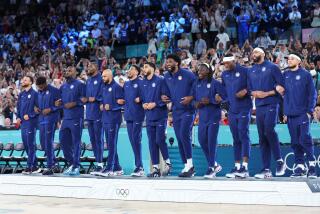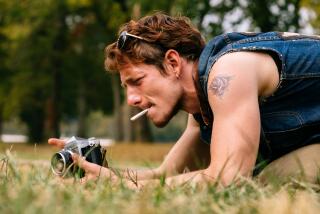Itâs Amazing How Far Bike Can Take You
PARIS â I really liked my first bike.
It was a black-and-white three-wheeler with a rubber bulb for a horn. Soft seat. Fuzzy handle grips. The sweetest little velocipede you ever did see.
I was every bit as cute on it as the kid in the movie âThe Omen,â going too fast, bumping into lamps, and terrorizing loved ones on stepladders. Mike the Tykeâs tryke, my uncle called it. Me, he called a Tasmanian devil on wheels. What a funny uncle he was.
My next bike was a red Schwinn with a mesh basket and a headlight. I delivered newspapers on it and was very quick, particularly due to a drooling, long-fanged German Shepherd which kept chasing me like he had just spotted the worldâs biggest Milk Bone.
Sometimes my pants cuff got snagged on the bicycle chain, so I would have to rip it free. Back home, I usually blamed this on the dog.
That bike saved my life a couple of times, beating this animal to safety by a nose. But, being a world-class klutz, it also nearly killed me once or twice. Training wheels were necessary until I was, oh, 18 or so. Later on, as an adult, I was the sort of guy who put training wheels on his Harley-Davidson.
The other thing I used to put on my bicycle was baseball bubble gum cards on the spokes. When they flapped between the spokes, they made a neat sound. I usually put Don Drysdale in the spokes. I never liked Don Drysdale.
All those years I was racing my bike around the neighborhood, though, it never occurred to me that you could race a bike for a living. Automobiles raced. Motorcycles raced. Even boats raced. But bicycles were for kids who had jobs after school, delivering pizza.
Greg LeMond found out otherwise.
When he was 16 years old in Reno, Nev., he went into Rickâs Bike Shop. He wanted a racing bike. He had just seen âBreaking Away,â a movie about a bunch of Indiana boys who rode in a race called the Little 500.
The salesman--maybe it was Rick--told Greg to forget about it.
âDonât get it. Youâll never stick to racing. Itâs much too difficult,â he said. Not exactly a hard sell. Rick wasnât over-eager to peddle those pedals.
LeMond bought the thing anyway. He had taken up biking two years earlier, mostly to get his legs in shape for skiing. Now he thought about doing some serious racing.
By 19, he was turning pro. Actually getting paid to ride the bikes. By 23, he was ready for the Tour de France, the richest and longest bike race in the world. He entered it and amazed the French by finishing third.
A year later, he finished second. And that brought him to 1986, to a sunny summer Sunday, to the most famous street in Paris.
Bike racingsâ new champ came whizzing down the Champs Elysees.
Past the Alfa Romeo car dealership. Past the Iraqi Airways travel office. Past the marquee that advertised a Walt Disney animated classic, âCendrillonâ--a fairy tale about a girl who defies her ugly stepsisters, meets a handsome prince and discovers that some dreams do come true.
LeMondâs bike went streaking by, his jersey a yellow blur. He was bound for the finish of the 73rd annual Tour de France, where he would become the first American ever to win. His personal Cinderella story was about to have a happy ending.
A huge crowd gathered to watch the denouement . The sidewalk cafes were mobbed. Scores of Frenchmen positioned themselves near a grating, and when women pedestrians passed by, gusts of air puffed their skirts as high as their thighs, Marilyn Monroe style, to the boulevardiersâ applause.
A car horn played the first few bars of âLa Marseillaise,â the way one in Mississippi might toot the first seven notes of âDixie.â Either one seemed the wrong song for a 25-year-old American who has called Nevada and California home. But then again, LeMond rode for a French team, was respectful of the tourâs storied traditions, and, considering athletes on the whole, was very possibly the most famous American in Paris.
As he bore down on the finish line, toward the âArriveeâ banner that marked the end of the arduous 2,543-mile race, LeMond lunged forward from his seat, hunching over the handlebars. He arched his back in triumph. Eighty-two years of European domination had been put to rest, and the leaderâs yellow jersey was the Americanâs to keep.
So ended the 23 days of LeMond.
He and hundreds of other bikers had begun this convivial pursuit on July 4. That same day, a statuesque debutante originally from France was making a Cinderella-like society bow in New York, holding a torch.
âThe Fourth of July--hey, the perfect day to start the Tour de France,â said LeMond at a public appearance of his own, in Belgium, a few days before the race. âPerfect for me, anyway.â
He turned to one of his teammates on the 10-man La Vie Claire team, Steve Bauer, a Canadian, and told him that even he, Bauer, would be happy if he could wrap himself in a U.S. flag at the finish line.
To which Bauer said: âNo, the only All-American boy here is you, Greg.â
LeMond has a home in Belgium. He also has one in Sacramento. He has a four-year professional contract worth $1.4 million. He endorses Huffy bikes and Puma sportswear. He got $25,000 for winning Sunday.
My uncle gave me a nickel once.






